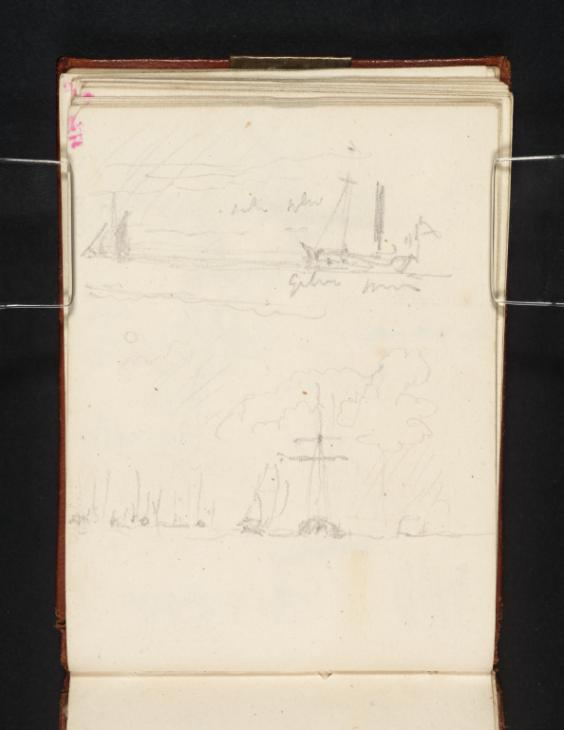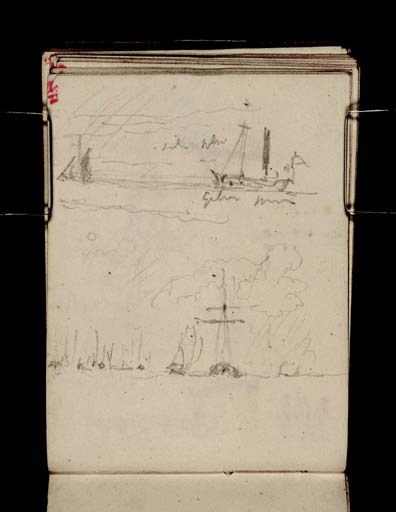Joseph Mallord William Turner A Lightship on the Goodwin Sands; a Yacht Passing a Moored Ship 1827
Image 1 of 2
Joseph Mallord William Turner,
A Lightship on the Goodwin Sands; a Yacht Passing a Moored Ship
1827
Joseph Mallord William Turner 1775–1851
Folio 37 Verso:
A Lightship on the Goodwin Sands; a Yacht Passing a Moored Ship 1827
D18061
Turner Bequest CCVII 37a
Turner Bequest CCVII 37a
Pencil on white wove paper, 100 x 74 mm
Inscribed by Turner in pencil ‘[?light blue]’ towards top centre, and ‘[?Goodwin Sands]’ towards top right
Inscribed by Turner in pencil ‘[?light blue]’ towards top centre, and ‘[?Goodwin Sands]’ towards top right
Accepted by the nation as part of the Turner Bequest 1856
References
1909
A.J. Finberg, A Complete Inventory of the Drawings of the Turner Bequest, London 1909, vol.I, p.627, CCVII 37a, as ‘A light ship’.
With the page turned vertically, there are two small seascapes here. At the top is what Finberg recognised as a lightship, that is to say a moored ship acting as a lighthouse. Turner’s inscription below it appears to read ‘Goodwin Sands’, indicating the ten-mile-long, treacherous sandbank, the site of many wrecks in the English Channel off the east coast of Kent. It is currently marked by the East Goodwin Lightvessel and various buoys.1 Turner depicted the feature in contrasting circumstances in two watercolours: Cricket on the Goodwin Sands, probably of the late 1820s (Yale Center for British Art, New Haven)2 and Wreck on the Goodwin Sands: Sunset, probably made in the late 1840s (Morgan Library & Museum, New York).3
Some sources suggest annual matches on the sandbank originated in 1824, and they have very occasionally been played in recent years.4 The combination of blue paper with watercolour and gouache in the Yale work is comparable with the media of studies Turner made at Petworth House (mostly Tate; Turner Bequest CCXLIV) following the late summer visit to the Isle of Wight recorded in other sketches in the present book. This suggests the possibility that he witnessed or even participated in such a game on the sands at low tide on a voyage east along the Channel from Cowes (see the slight views apparently of Dover Castle on folio 13 recto; D18013). See also the ink, chalk and pencil on blue paper works included in the present Isle of Wight section (Tate; Turner Bequest CCXXVII a, CCXXVIII).
Below is a study of a moored ship with a yacht passing, and the masts of other shipping beyond. The sun is shown high above billowing clouds. The setting might be Cowes or elsewhere along the South Coast. For more on studies in this sketchbook relating to the regatta events at Cowes from late July 1827 onwards, see the sketchbook Introduction.
Matthew Imms
December 2014
See ‘East Goodwin Lightvessel’, Trinity House, accessed 1 September 2014, http://www.trinityhouse.co.uk/lighthouses/light_vessels/east_goodwin_lightvessel.html .
Andrew Wilton, J.M.W. Turner: His Life and Work, Fribourg 1979, p.407 no.916, reproduced, as ‘?c.1828–30’.
How to cite
Matthew Imms, ‘A Lightship on the Goodwin Sands; a Yacht Passing a Moored Ship 1827 by Joseph Mallord William Turner’, catalogue entry, December 2014, in David Blayney Brown (ed.), J.M.W. Turner: Sketchbooks, Drawings and Watercolours, Tate Research Publication, November 2016, https://www


